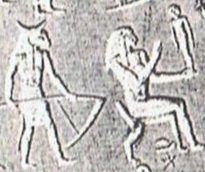In this chapter it has been necessary to use a kind of 'cosmic frame' as a guide, which led to many extra pages. The tagata toki glyph type, where tagata and toki are illustrated as a single entity, presumably was used in the rongorongo system to indicate the arrival of a new Sun Child early in the year, for instance as in Ga2-1:
Another kind of toki glyph (which we can name hipu toki) is located as glyph number 548 (counted from Ea1-1) in the Keiti text. It is aparently sometimes possible to use combinations of texts from different tablets in order to find clues to how glyphs should be understood. In Eb7-2 the basic figure is not tagata but hipu, which could mean the light arrives from a lower position. Comparing with the iconography of the round Dendera zodiac we can contrast hipu toki with the Khnum figure carrying a henen (mattock):
Although it is a dark time (early in the year south of the equator) the happy result of digging in the earth is the arrival of progeny. The open arm gesture of the following goddess welcomes her new baby. From the perspective of Egypt it is a Moon child (we can see the two arms of the child). From the perspective of Easter Island, on the other hand, it ought to be a Sun child which arrives in spring. Toki should be held high towards the sky, not low towards the earth. Sky and earth are separating and light will enter. The plane of the ecliptic is rising above the earth, which creates a 'yawn' in the sky. The dark 'primal embrace' is over. From the beginning lines on side a of the Keiti tablet it is possible to guess what the different variants of toki mean, for instance:
|









